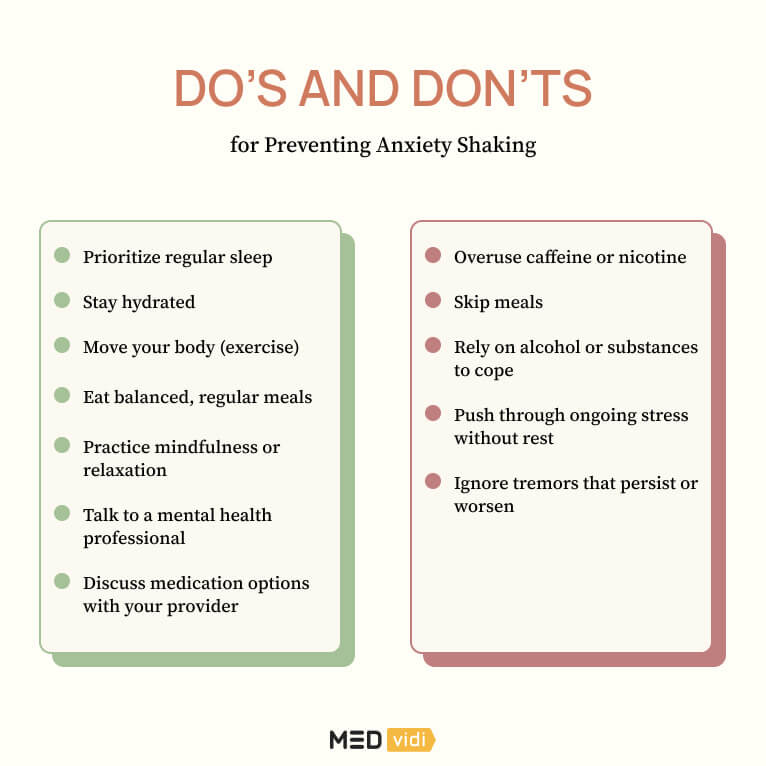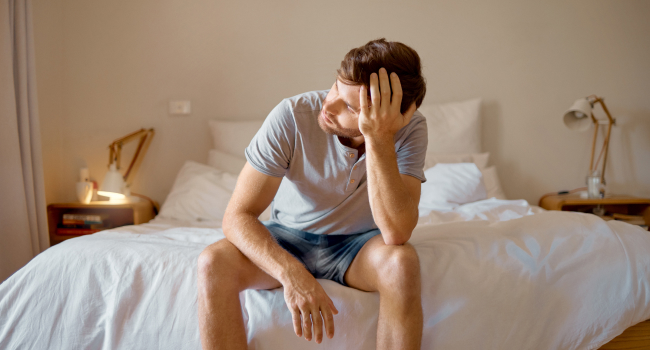Highlights
- Anxiety shaking happens when stress hormones like adrenaline activate your muscles, making them tremble.
- Anxiety tremors are different from neurological or psychogenic tremors, which have other underlying causes and patterns.
- Quick strategies like deep breathing, grounding techniques, or gentle movement can calm shaking in the moment.
- Long-term treatment options include therapy, lifestyle changes, and sometimes medication to address the root cause of anxiety
Anxiety doesn’t just affect your mind. It also shows up in your body, and one of the most unsettling and frightening symptoms can be shaking. For example, you might notice your hands trembling during a presentation. Or your entire body might shake uncontrollably when you’re under a lot of stress. Either way, many of us shake when we’re scared.
For some people, anxiety shaking is barely noticeable. But for others, it can feel so intense that it interferes with daily life.
In this article, we’ll explain what you need to know about anxiety shaking and how to stop shaking when you’re nervous. Understanding it may help you feel less afraid when it happens.
What Is Anxiety Shaking?
On top of its emotional aspects, anxiety can also come with physical symptoms. Anxiety shaking is when your body starts physically trembling as a response to stress.
People experience “anxiety shakes” differently. For some, it might be more subtle and internal, like feeling that your hand is slightly shaking. For others, it might be so intense that it’s visible to others.
Note that tremors and shaking can have various medical causes, and it’s important to rule them out. Rare conditions, like Parkinson’s Disease, can cause neurological tremors.

Symptoms and Types of Anxiety-Related Shaking
Anxiety-related shaking can appear differently, from slight tremors in specific body parts to whole-body jitters. Below are a few examples.
Shaky Hands and Fingers
When you’re very anxious or nervous, you might notice your hands or fingers shaking before any other body part. For example, you might find that it’s hard to bring a glass of water up to your mouth.
This is due to a few different reasons. First, your hands are full of fine motor muscles, which are more sensitive to stress hormones (like adrenaline) than larger muscle groups. Also, you may be more likely to notice your hands shaking than other body parts; it’s easier to spot when they are trembling because you use them for so many daily tasks.
Full-Body Tremors and Muscle Jitters
But your hands aren’t the only body part that can be affected by anxiety. Many people find that their whole body shakes when they’re anxious. Whole-body shaking from anxiety can make it difficult to walk or function. You might feel jittery all over, and even need to steady yourself in order to stay calm.
Internal Shaking Sensation
Sometimes, anxiety-related shaking isn’t visible. You might feel like you’re shaking inside, even though no one else can tell. But this doesn’t make anxiety shaking any less valid. It still feels real to you, and it can be very scary.
Nighttime Tremors
Many people find that their anxiety tremors are worse at night. Your mind might start racing more when trying to fall asleep — you are no longer busy, and the idle time can cause your anxious thoughts (and subsequent tremors) to
Other Physical Symptoms
Anxiety shaking often comes along with other physical symptoms:
- Rapid heartbeat
- Sweating
- Nausea, vomiting, or stomach cramps
- Feeling dizzy or fainting
- Muscle weakness or tension
Emotional Symptoms
Some of the emotional symptoms of anxiety include:
- Panic; feeling like you’re out of control or even that you’re going to die
- Excessive worries
- Dissociation (depersonalization or derealization)
- Irritability
- Restlessness
- Trouble concentrating
Anxiety Tremors vs Other Tremors
Although anxiety may cause tremors, it is not the only reason. These are a few common examples:
Essential tremor[2] is the most prevalent type and one of the most common movement disorders. It happens repeatedly and consistently; usually, during movement, for example, when a person uses their hands or arms, and also often affects the head or voice.Parkinsonian tremor[3] is a symptom of a neurological condition called Parkinson’s disease. Unlike essential tremor, it typically occurs at rest and tends to lessen during an activity.Psychogenic tremor[4] is considered a functional movement disorder, which means it’s not caused by any neurological condition. It can occur as a response to severe anxiety, stress, or traumatic experience (instead of an immediate response to a scary situation).
The only way to know for sure whether your shaking is anxiety-driven or not is to talk with a qualified healthcare provider. They can rule out medical causes of shaking and assess you for an anxiety disorder. Especially if your shaking hasn’t gone away after the stressful situation ended, it’s important to seek medical attention right away.
|
Anxiety shaking |
Neurological tremor |
Psychogenic tremor |
|
|
Onset |
Sudden, when an anxiety-provoking event happens |
Gradual, develops with an underlying condition |
Variable; can start suddenly and change over time |
|
Duration |
Temporary; resolves when anxiety decreases |
Persistent and chronic |
Can fluctuate; may disappear with distraction |
|
Triggers |
Stress, fear, social situations, panic |
Neurological disease, medication side effects |
Psychological stress, trauma, attention to the tremor |
|
Other symptoms |
Racing heart, sweating, dizziness |
Muscle stiffness, coordination problems |
Changes in tremor pattern, inconsistent presentation |
Why Does Anxiety Cause Shaking?
There are biological and lifestyle reasons why anxiety can cause your muscles to shake.
Adrenaline and the Fight-or-Flight Response
As part of the fight-or-flight reflex, your body releases certain hormones — like adrenaline and cortisol — into your bloodstream to get ready to face potential dangers. These hormones directly lead to physical reactions.
For example, more blood flow rushes to your muscles to help you fight (or run away). This increased blood flow, especially to fine motor muscles like your hands, can cause shaking.
Nervousness and Anticipatory Anxiety
You might notice shaking even before something stressful happens — like waiting for an exam to start or walking up to give a speech. This is anticipatory anxiety. Your body reacts as if the danger is already here, and the adrenaline surge can make you shake.
Hyperventilation and Muscle Tension
Another physical symptom that can come along with anxiety is shortness of breath. Under more extreme situations, like panic attacks, you might even find yourself hyperventilating. This change in breathing rapidly alters blood chemistry, which can lead to dizziness and jittery muscles.
Stress and Fatigue
Anxiety can lead to fatigue, both directly and indirectly. It’s exhausting to live day after day with excessive worries circling through your brain, which can directly make you feel more tired than usual. Anxiety can also make it harder to sleep, which can cause you to be sleep-deprived. Either way, chronic fatigue can make your muscles shaky.
Lifestyle Factors
Living with anxiety can also make you more likely to have lifestyle habits that contribute to tremors. For example:
- Consuming too much caffeine (or other stimulants) can worsen anxiety and cause jitteriness.
- Drinking too much alcohol — although it may feel relaxing in the moment, it can cause increased anxiety later on.
- Using nicotine is known to cause shakiness as a side effect.
- Being dehydrated can increase fatigue and make you feel shaky.
- Low blood sugar due to skipping meals can also be a cause.
Common Triggers and Who’s More Susceptible
Stress and anxiety are subjective. What one person finds extremely anxiety-provoking, another person may be able to cope with well. Generally, things that you find more stressful and anxiety-provoking are more likely to cause you to shake.
Situational Triggers
Some common triggers of anxiety include:
- Public speaking
- Social interactions
- Exams
- Conflicts or confrontation
- Health worries
People tend to experience anxiety tremors before and during temporary, intensely anxiety-provoking events.
Susceptibility Factors
Some people are more likely to experience both anxiety in general and anxiety-related shaking than others. The causes of anxiety are complex; many different factors come together to heighten the risk.
Some of the risk factors include:
- Genetics and Family History: People who have direct relatives with anxiety disorders are more likely to live with anxiety themselves.
- Personality Traits: People who are more sensitive to stress, perfectionistic, or highly self-critical often feel anxiety more intensely.
- Chronic Health Conditions: Thyroid problems, neurological conditions, or heart conditions can increase the likelihood of both anxiety and tremors.
- Sleep Difficulties: Ongoing insomnia or poor sleep quality can make your body more vulnerable to anxiety and jitteriness.
- Substance Use: High caffeine intake, frequent nicotine use, or alcohol withdrawal can all worsen anxiety and shaking.
- Stressful Life Experiences: Trauma, ongoing stress at work or school, or major life changes can increase anxiety symptoms.
How to Stop Shaking From Anxiety Immediately
It can be a very scary experience to start shaking from anxiety. You might not understand what’s happening, and it can feel like your body is out of control. But there are ways to calm your nervous system and stop shaking.
Here are the strategies to try:
- Breathe deeply to slow adrenaline.
- Relax tense muscles.
- Use grounding or sensory input.
- Move gently (walk, stretch, shake your hands).
- Reframe thoughts or distract the mind.
- Stay hydrated and avoid stimulants.
Breathing Resets
Certain breathing techniques directly trigger your body’s relaxation response, which calms your nervous system. This can help your body get out of fight-or-flight and stop shaking.
Some breathing techniques to try include:
- Box Breathing (4-4-4-4): Trace an imaginary square with your finger in a clockwise fashion. As your finger travels to the right along the top “line” of the square, breathe in slowly for a count of 4. As your finger moves down, hold your breath for 4. Moving along the bottom, breathe out for 4. Finally, as your finger goes up the other side, hold again for 4. Continue tracing the square, maintaining the 4-count pattern for each side — inhale, hold, exhale, hold.
- 4-7-8 Breathing: This common breathing exercise also involves inhaling, holding your breath, and exhaling slowly. Breathe deeply through your nose and into your belly for 4 counts. Then, hold your breath in for 7 counts (this shouldn’t be painful). Then, let the air out slowly, through your mouth, for 8 counts.
- Diaphragmatic Breathing: This is a simple technique where you focus on breathing deeply and slowly into your diaphragm or belly. Often, when we’re anxious, we end up taking fast, shallow breaths — but this only makes you feel even more anxious. So by slowing down your breathing, you can become less anxious and manage the shaking.
Progressive Muscle Relaxation (PMR)
Progressive muscle relaxation is an evidence-based technique that can help calm your body’s stress response. To practice it, you move through your body one muscle group at a time — tensing each group for a few seconds, then releasing it completely. For example, you might start by clenching your fists, holding the tension for 5 seconds, and then letting them loosen fully.
Grounding and Sensory Overrides
Sometimes, when you’re shaking from anxiety, you might start to dissociate. Grounding can help bring you back to the here and now, reconnecting to your physical experience in the present moment.
Some effective methods include:
- 5-4-3-2-1 Method: Name five things you see, four you feel, three you hear, two you smell, and one you taste.
- Holding Cold Objects: Ice cubes or cold water can “override” anxious sensations.
- Focusing on Textures: Run your fingers over something with a noticeable texture, like fabric or wood.
These and other grounding techniques can help stop adrenaline shakes by reminding your body there’s no immediate threat.
Gentle Physical Activity
Exercise and physical activity have so many benefits. Not only can a single session of exercise decrease stress, but moving your body can also be a great way to ground yourself. For example, you might take a walk, do some gentle stretching, or find another form of light movement (like yoga or dance). Even short bouts of movement can help you get anxiety tremors under control.
Cognitive Pivots and Distraction
The mind is so powerful that it can cause you to feel so anxious to the point of physical symptoms like shaking. However, this also means that you can address the root of anxiety shaking by trying to reframe your thoughts or simply distracting yourself from whatever is making you feel anxious.
For example, name and label the emotion, especially if you feel out of control. Tell yourself: “I’m not crazy, I’m just scared. The shaking is a natural response to stress, and I’m able to calm down.” You can also try to engage in some relaxing distractions, like listening to music or calling a friend.
Long-Term Management and Prevention
Although these strategies can help you stop anxiety shaking in the moment, it’s also important to address the root issue — anxiety — so that you can prevent it from happening again. Anxiety is hard to live with, but it’s manageable with the right treatment and support.
Therapy and Professional Support

Anxiety Medication Overview
Some people may also choose to take medication to help them manage anxiety, including symptoms like anxiety shaking. Medication can be especially helpful for shaking during anxiety attacks because some medications are designed to stop such symptoms in the moment.
The most effective medications that are used for anxiety include:
- Antidepressants, such as selective serotonin reuptake inhibitors (SSRIs) and serotonin norepinephrine reuptake inhibitors (SNRIs)
- Beta-blockers
- Benzodiazepines
Beta-blockers and benzodiazepines can be used to manage intense episodes of anxiety. Benzodiazepines, in particular, are best used short-term because they carry the risk of abuse and addiction, so it’s important to use them carefully under your healthcare provider’s close supervision.
Lifestyle Changes
If you live with an anxiety disorder that’s leading to tremors or shaking, then lifestyle changes alone probably aren’t enough to help you manage it completely. But they can make a big difference, especially alongside professional treatment.
Consider making the following lifestyle changes:
- Avoid overusing nicotine, caffeine, and other substances that are known to increase anxiety and jitteriness.
- Prioritize getting restful sleep each night so that you’re not fatigued.
- Eat nourishing, balanced meals, and don’t skip meals.
- Stay hydrated.
- Don’t rely on alcohol or other maladaptive coping mechanisms to get through stress.
- Pay attention to warning signs that your stress levels are getting too high.
- Get medical attention if your tremors continue or get worse.

When to Seek Medical Advice
Tremors have many potential causes, not only anxiety. Moreover, anxiety itself can co-exist with many other medical conditions. So, if you’re experiencing tremors on a regular basis, it is necessary to see a medical provider to determine the cause. At MEDvidi, you can get personalized anxiety treatment online, from the initial assessment of your symptoms to ongoing support.
Seek immediate medical attention if:
- Your tremors are long-lasting; they continue even when you’re not feeling anxious.
- Tremors and shaking have gotten worse over time.
- You’re experiencing other neurological symptoms, like muscle stiffness, dizziness, or loss of balance.
- You experience tremors when you take a certain medication or substance.
- You’re worried about your symptoms.
Conclusion
Anxiety shaking can feel overwhelming, especially if it happens in public or interferes with daily life. But it’s a common response to stress, and there are proven ways to calm your body both in the moment and over the long term. You can learn to manage anxiety tremors and feel more in control again.
At MEDvidi, our licensed providers can help you understand your symptoms and find the right treatment plan, including online medication prescription, if deemed necessary. If anxiety shaking has been affecting your quality of life, book an appointment today to get connected with a professional.
FAQs About Anxiety and Shaking
Is shaking a sign of anxiety?
Anxiety can activate your fight-or-flight response, which may make your muscles tremble. However, anxiety is not the only reason, so if shaking or tremors are persistent or prolonged, seek medical advice.
Can anxiety cause tremors?
Do psychogenic tremors go away?
How do you calm anxiety tremors?
Why do I shake when I’m nervous or scared?
Your body is releasing adrenaline to prepare you for facing danger. That extra energy can cause your muscles to tremble.
How long can anxiety tremors last?
They usually fade once the anxiety passes, but can last minutes to hours depending on the situation and stress levels.
Can anxiety shaking happen at night?
Does uncontrollable shaking mean I have a panic attack?
Shaking alone doesn’t always mean you’re having a panic attack. Other symptoms — like shortness of breath, racing heart, the feeling of impending doom, or fear of dying — usually happen alongside shaking.













